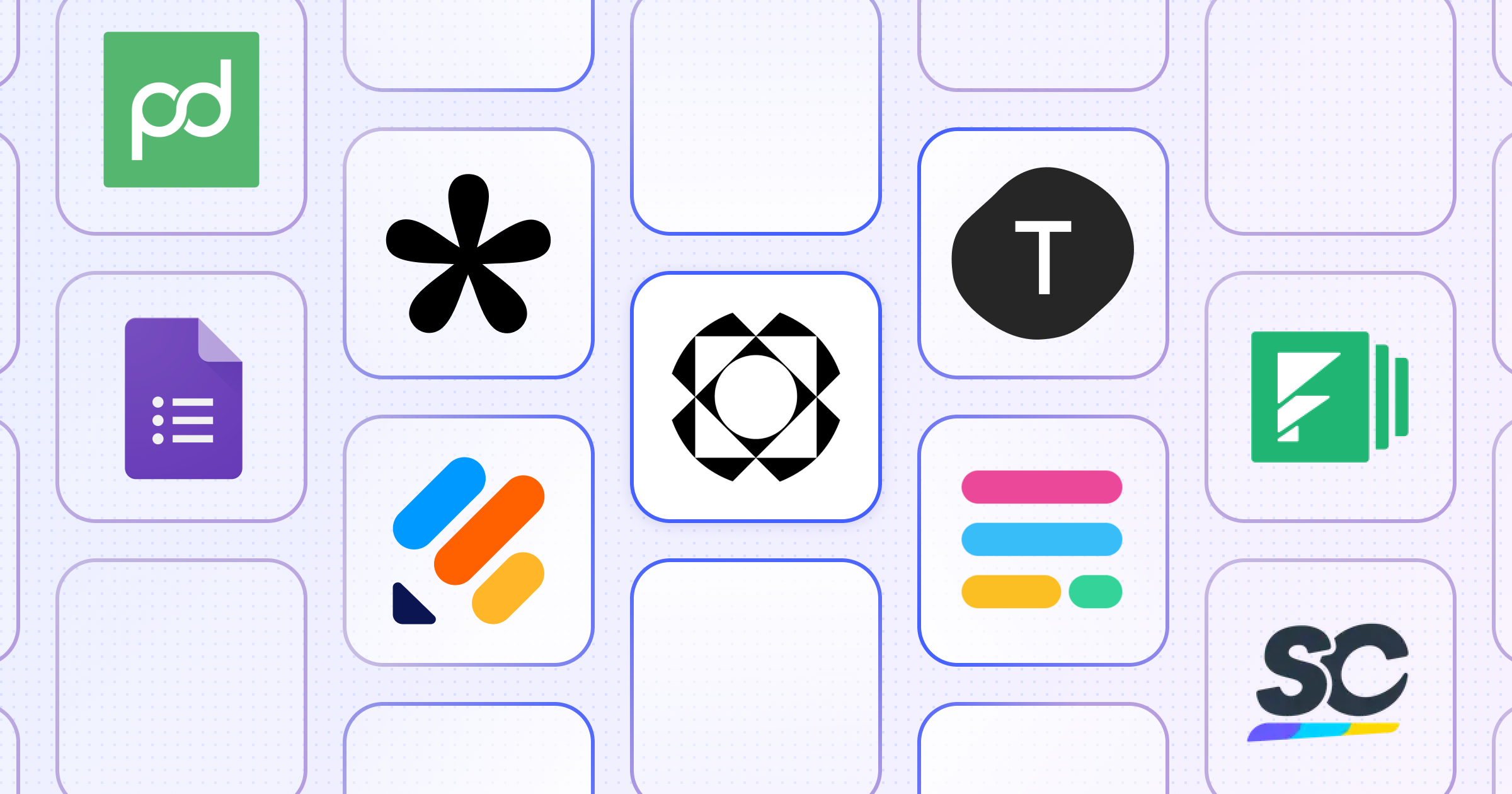
Form automation software transforms tedious manual processes into streamlined, automatic workflows, saving time and reducing errors.
The benefits are clear: increased productivity, improved data management, and enhanced customer experiences.
In this post, we’re diving into real-life examples of form automation across diverse industries, comparing top tools like Paperform, Tally Forms, and others.
Plus, we'll show you how integrating these tools with Relay.app can take your workflows to the next level.
Let's get to it. ⬇️
What is Form Automation Software?
Form automation is the technology that replaces manual form filling and data entry with automated processes.
It utilizes software solutions to capture, process, and integrate data entered into forms across various platforms.
This technology streamlines data collection, reducing human errors and increasing the efficiency of data handling.
Whether it's online applications, surveys, or registration forms, form automation ensures that the data flows smoothly from the user directly into the necessary databases or systems, often in real-time.
It's about making the collection and utilization of information as effortless and error-free as possible.
Why Use Form Automation Software?
Form automation software isn't just a luxury! It's a necessity.
Here are four compelling reasons why investing in form automation software can be transformative for your business:
Reason 1. Reduce operational costs
Automating form-related tasks minimizes the need for manual data entry, which reduces labor costs speeds up the entire data processing cycle.
This allows your team to focus on more strategic tasks, ultimately boosting productivity and cutting down on operational overhead.
Reason 2. Better data accuracy
Human error is a common issue in manual data entry, but form automation software can significantly mitigate these errors.
By automating the input process, the software ensures that data is entered consistently and correctly, leading to more reliable data.
Accurate data is crucial for effective decision-making and improving business operations.
Reason 3. Better customer experience
Form automation can dramatically improve the interaction between your business and your customers.
Automated forms are quicker to fill out and can be optimized for user-friendliness.
This not enhances the customer’s experience and also increases the likelihood of form completion, ensuring you capture essential customer data efficiently.
Reason 4. Easier compliance
For industries that require strict compliance with regulations, automated forms ensure that data collection and handling procedures meet necessary legal standards.
Features like audit trails, data encryption, and secure data storage can help maintain compliance.
Features of Form Automation Software
Form automation software offers a suite of powerful features designed to automate and optimize data collection and workflow processes.
Here are some of the key features commonly found in form automation platforms:
Conditional logic and rules

This feature allows forms to dynamically change based on user inputs. For example, certain questions can be hidden or displayed based on previous answers, making the form more relevant and easier to navigate for users.
This not only improves the user experience but also ensures that the data collected is tailored and specific.
Success pages and redirects
Upon completion of a form, users can be redirected to a custom success page or a different website.
This feature is useful for guiding users to additional resources, confirming submission, or continuing the user journey without requiring separate navigation steps.
Calculations
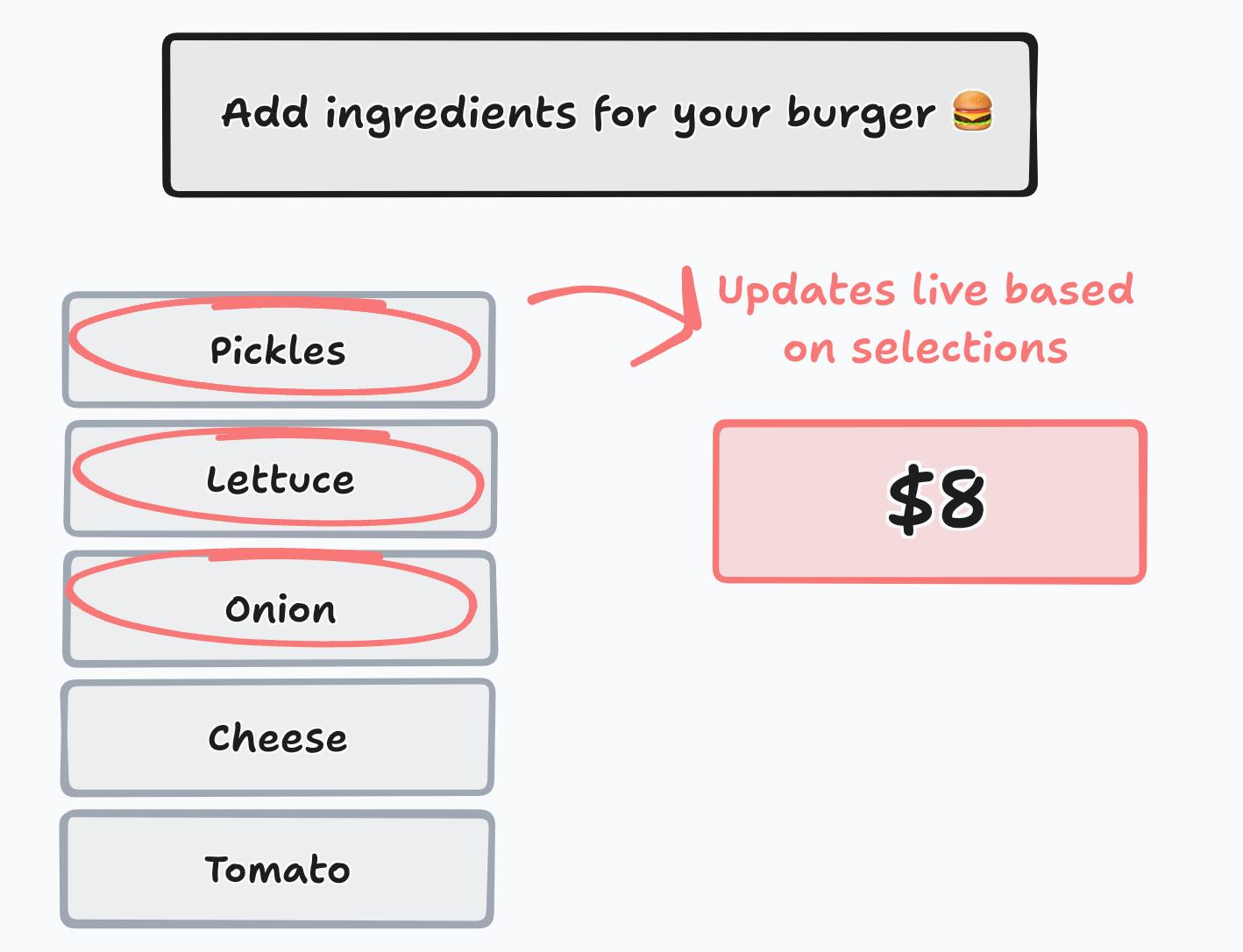
Form automation software often includes the ability to perform calculations based on user inputs. This can be useful for applications like order forms, where totals need to be calculated, or scoring systems for assessments and quizzes.
Automating these calculations ensures accuracy and efficiency, providing immediate feedback to the user and reducing manual calculation errors.
Integrations
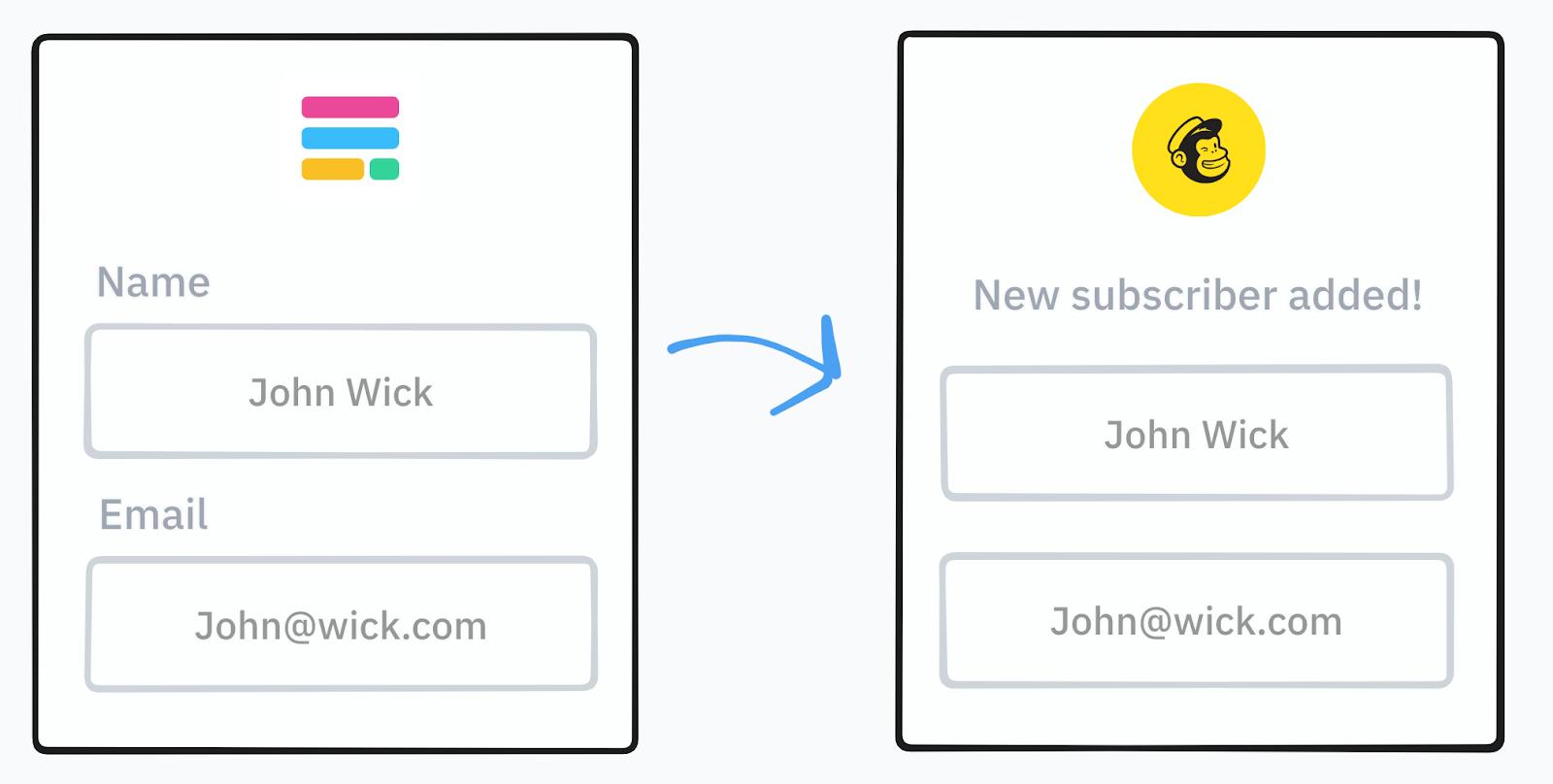
Form automation tools typically offer integrations with a variety of other software systems such as CRM platforms, email marketing services, and cloud storage solutions.
These integrations enable seamless data transfer between systems, automating tasks like updating customer records, triggering email campaigns, or storing submissions, without manual intervention.
Built-in workflows
Many form automation solutions come with tools to create and manage workflows directly from the form responses.
These can include assigning tasks to team members, triggering approval processes, or initiating follow-up actions based on the data received.
This level of automation streamlines operations and can significantly reduce the workload on staff.
Form Automation Examples
Form automation can revolutionize the way organizations operate, making processes more efficient and user-friendly.
Here are three examples of how form automation can be applied in different industries:
Scenario 1: Dog-walking business
Imagine you run a dog-walking business. 🐕🏃♂️
Before the first walk, you send clients a form to gather important information about their pet, such as breed, age, medical history, and walking preferences.
By using form automation software, you can set up a system where this information directly integrates into your scheduling system and customer database.
Automatic reminders can be set for clients to update their information annually or as needed, ensuring you always have up-to-date details, which can be crucial for providing the best care.
Scenario 2: Event management
Alright, let's switch gears to event management.
Event organizers often deal with numerous forms for vendor registrations, participant sign-ups, and feedback collections.
By automating these forms, the data collected can automatically populate into your event management software, helping to track attendance, preferences, and logistical needs.
Automated emails can be sent to participants with event details, updates, and post-event thank you notes, streamlining communication and enhancing attendee experience.
Scenario 3: Healthcare clinics
In a healthcare setting, patients are often required to fill out extensive forms regarding their health history before consultations.
Automating these forms allows for the secure collection and storage of patient data in electronic health records (EHR).
Integration with scheduling tools ensures that patient appointments are coordinated with their health records for better preparedness.
Additionally, automated follow-up forms for patient feedback or reminders for annual check-ups can improve ongoing patient care and satisfaction.
These examples are just a sample of what you can do. They demonstrate the versatility and efficiency of form automation across different sectors.
10 Best Form Automation Software in 2024
Alright, so now we know a bit about what you can achieve with form automation software, let’s take a look at the existing solutions.
These options represent a cross-section of the best tools in the market for automating form processes in various business contexts, from simple surveys to complex, compliance-driven workflows.
Each tool offers unique features catering to specific needs and industries, making it easier for businesses to choose the right solution for their operations.
Each tool is briefly summarized with its features, pricing, and a balanced look at its pros and cons.
Let’s dive in. 🏊♂️
1. Paperform
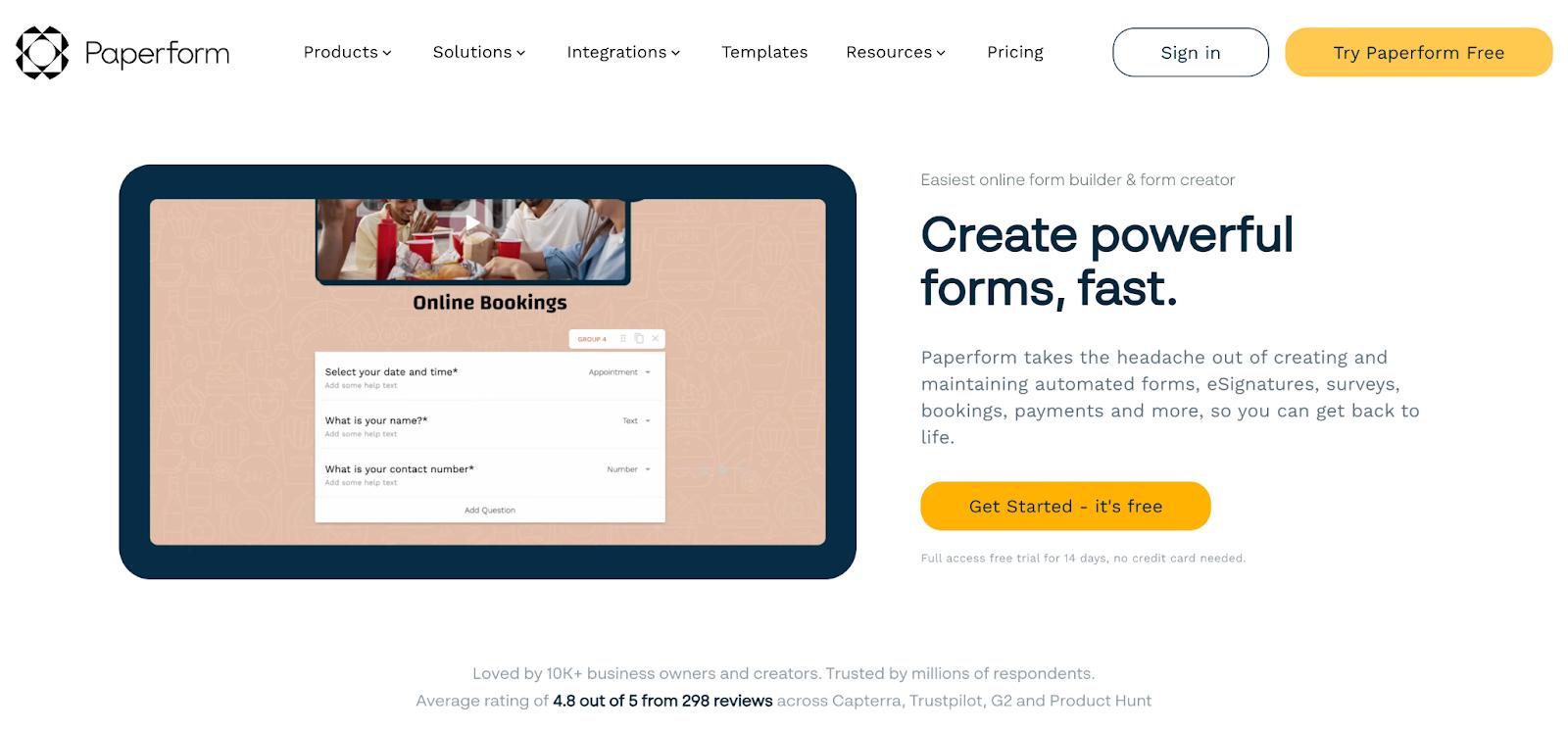
Paperform allows you to create forms that act more like landing pages due to their high customizability and rich content capabilities.
It's designed for businesses looking to blend forms with aesthetics without requiring extensive design skills.
Features:
- Rich text formatting and media integration
- Custom HTML/CSS for detailed customization
- Payment and subscription management tools
Pricing:
- Essentials at $20/month
- Pro at $40/month
- Agency pricing available on request
Pros and cons:
✅ Highly customizable
✅ Integrates with many platforms
❌ Higher cost than some alternatives
❌ Can be overwhelming for simple form needs
2. Tally Forms

Tally Forms offers a simple yet powerful approach to form building, making it easy to create forms quickly with a minimal learning curve.
Features:
- Unlimited forms and submissions in the free plan
- Built-in templates for quick setup
- Support for conditional logic and calculations
Pricing:
- Free plan available
- Pro version at $29/month
Pros and Cons:
✅ Extremely generous free plan
✅ Intuitive user interface
✅ Match made in heaven for Notion users
❌ Somewhat limited customization options
3. Fillout
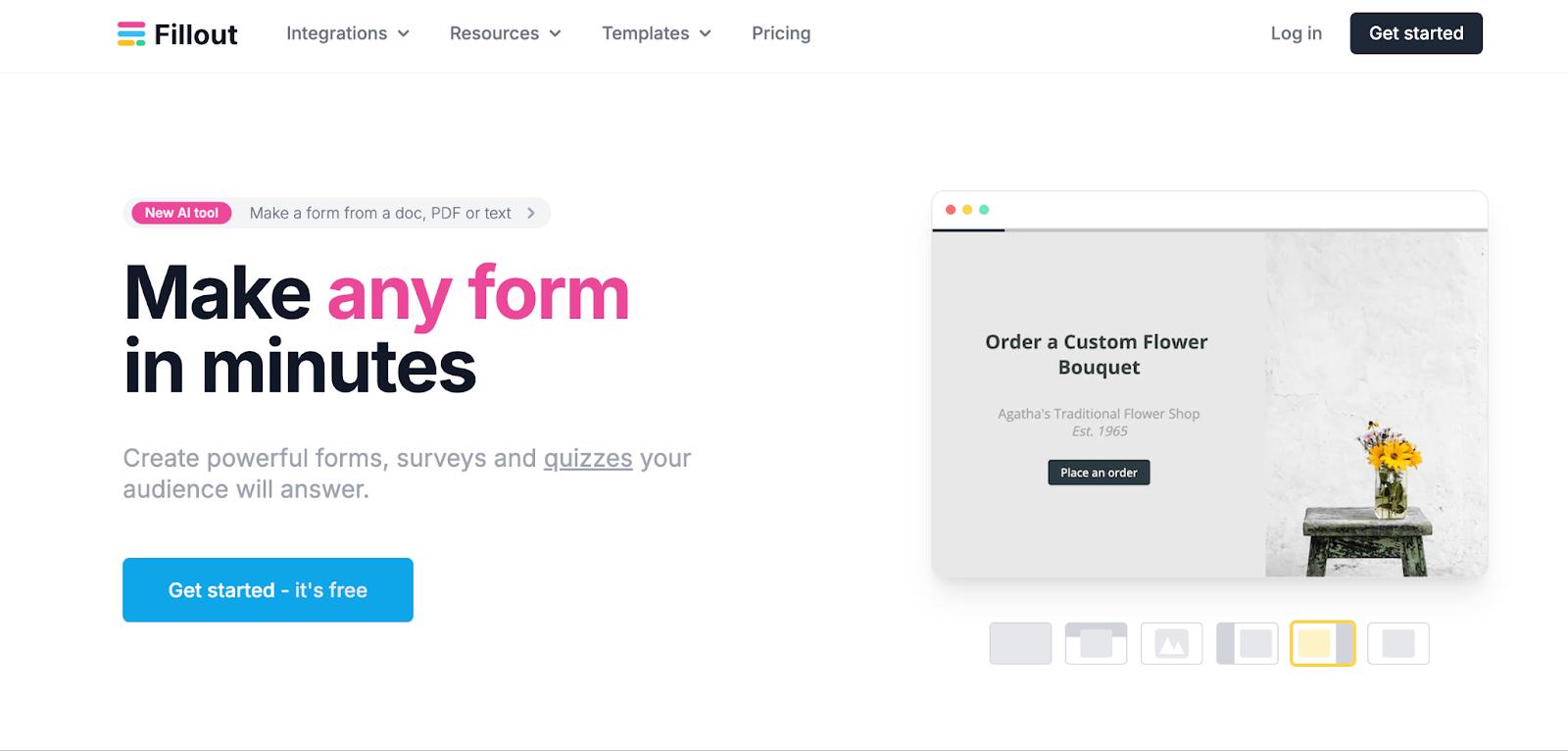
Fillout is ideal for mobile data collection, offering offline data capture capabilities and GPS data integration.
Features:
- Offline data collection
- Mobile-first design
- Real-time data synchronization
Pricing:
- Generous free plan
- Starter: $15/month
- Pro: $40/month
- Business: $75/month
Pros and Cons:
✅ Strong mobile functionality
✅ Offline capabilities
✅ Creative unique features like audio recording fields
❌ Relatively new to the space
→ Check out how you can build smart, automated forms with Relay.app and Fillout
4. Typeform
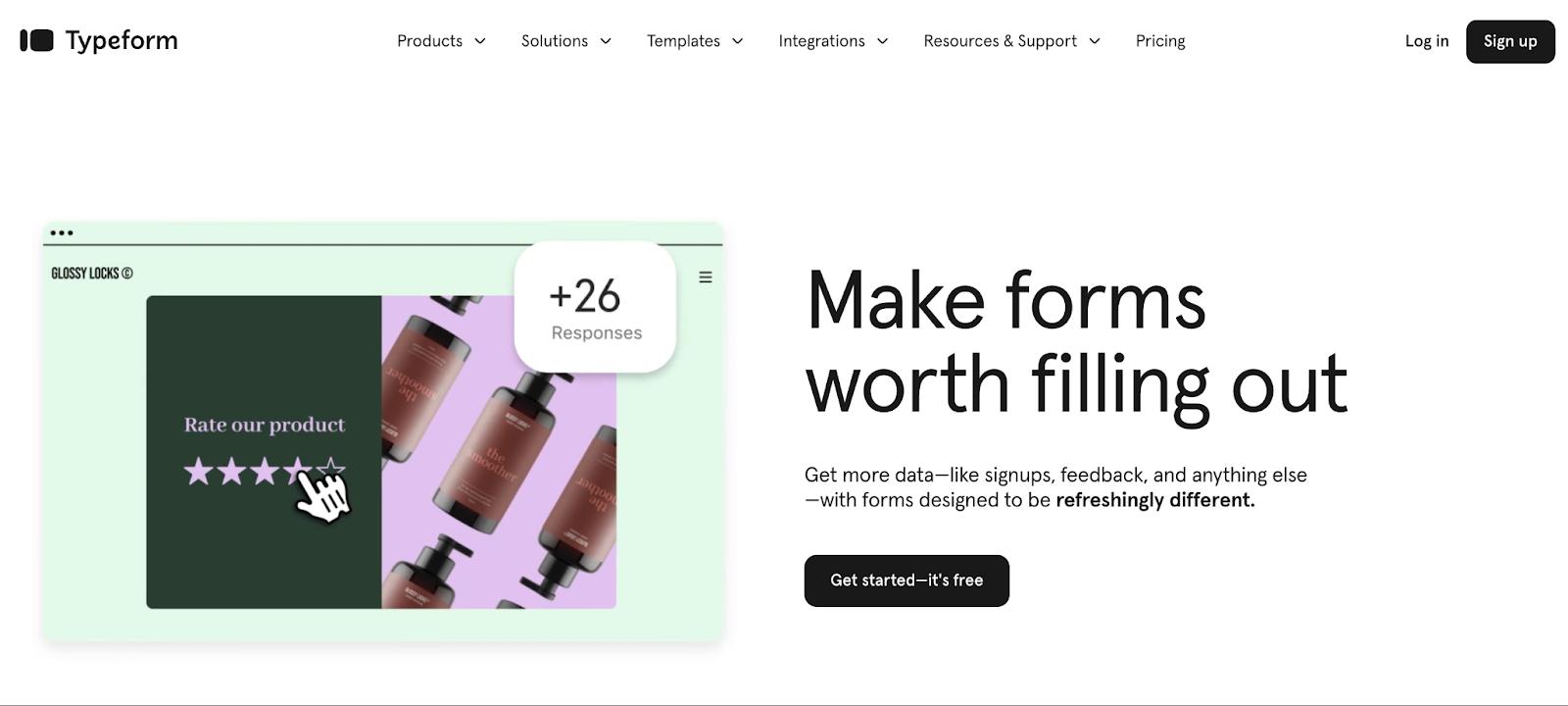
Typeform is known for its user-friendly interface and conversational forms that enhance the user experience significantly.
Features:
- Conversational form interface
- Extensive integration capabilities
- Advanced analytics dashboard
Pricing:
- Basic at $25/month
- Plus at $50/month
- Business at $83/month
Pros and Cons:
✅ Engaging user experience
✅ Sleek design
❌ Can be expensive for high-volume needs
❌ Sometimes feels like form over function
5. Jotform
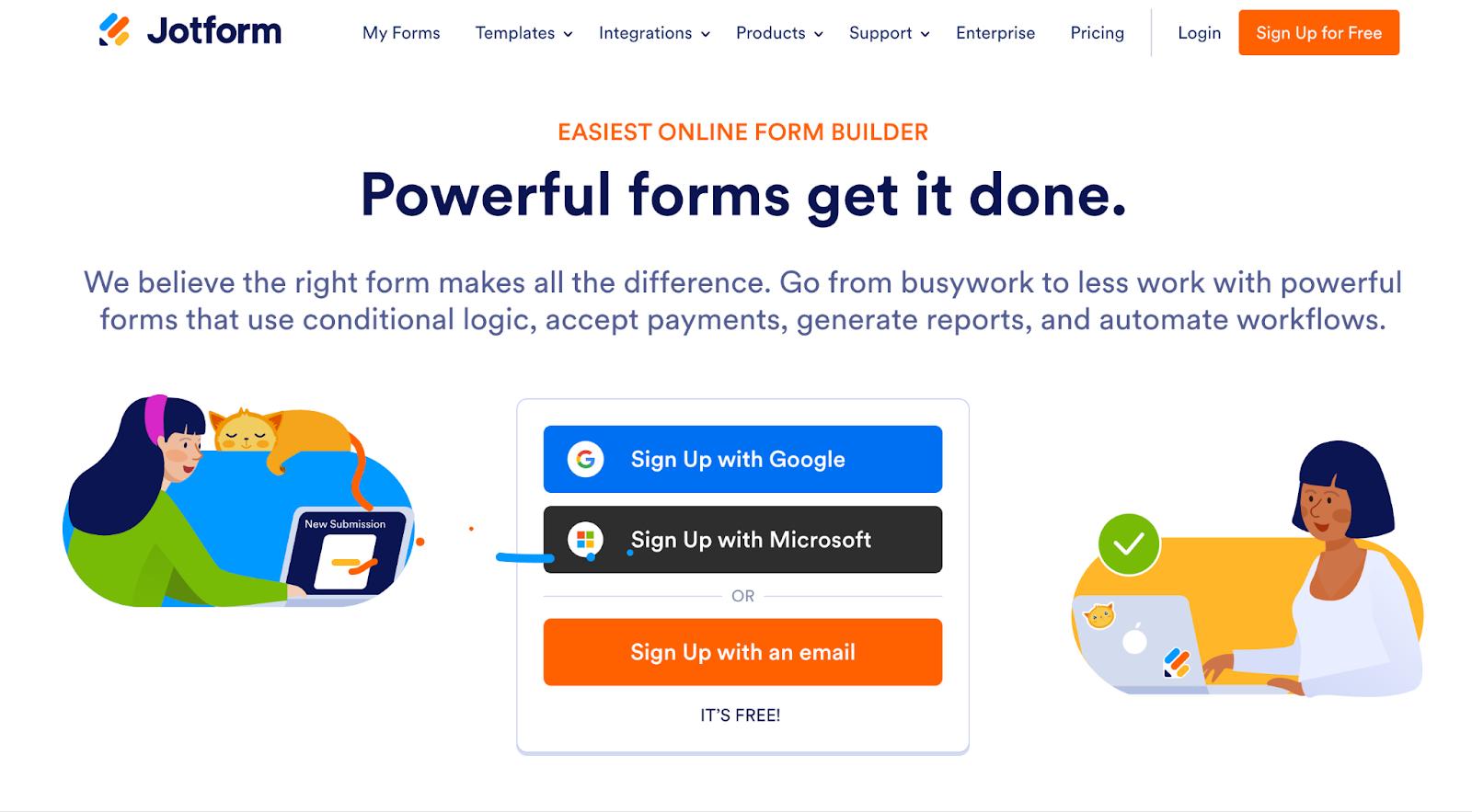
Jotform is a versatile form builder that serves a wide range of industries with its extensive template library and powerful integrations.
Features:
- Over 10,000 templates
- Advanced conditional logic
- Payment integrations
Pricing:
- Starter: Free
- Bronze: $39/month
- Silver: $49/month
Pros and Cons:
✅ Comprehensive template selection
✅ Strong integration options
❌ Some users find the interface clunky
6. Google Forms
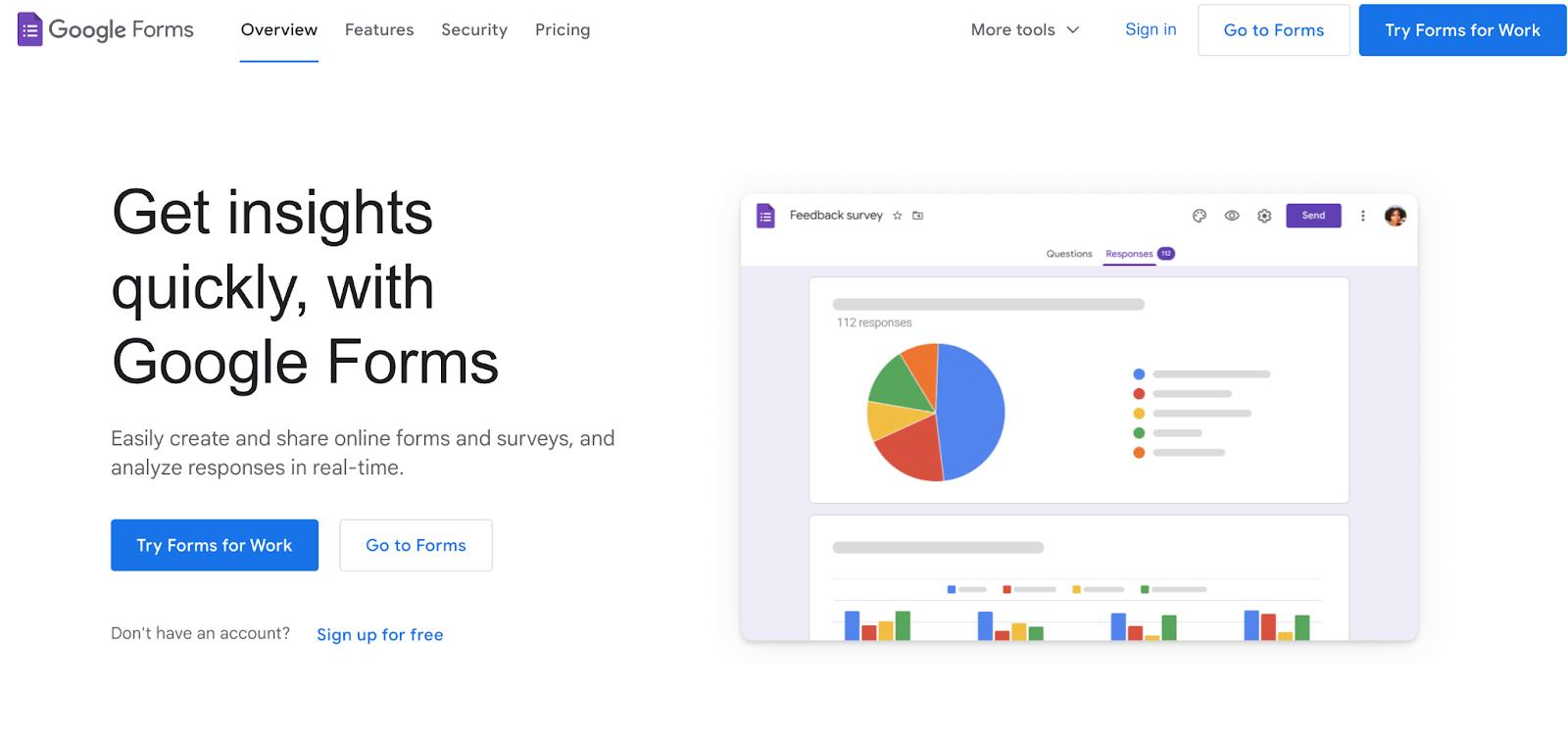
Google Forms provides a no-cost, straightforward form tool with seamless integration into the Google ecosystem, perfect for simple survey and data collection needs.
Features:
- Free to use with a Google account
- Real-time collaboration
- Automatic saving to Google Drive
Pricing:
- Free
Pros and Cons:
✅ Completely free
✅ Integrates perfectly with other Google services
❌ Limited customization and advanced features
7. Formstack
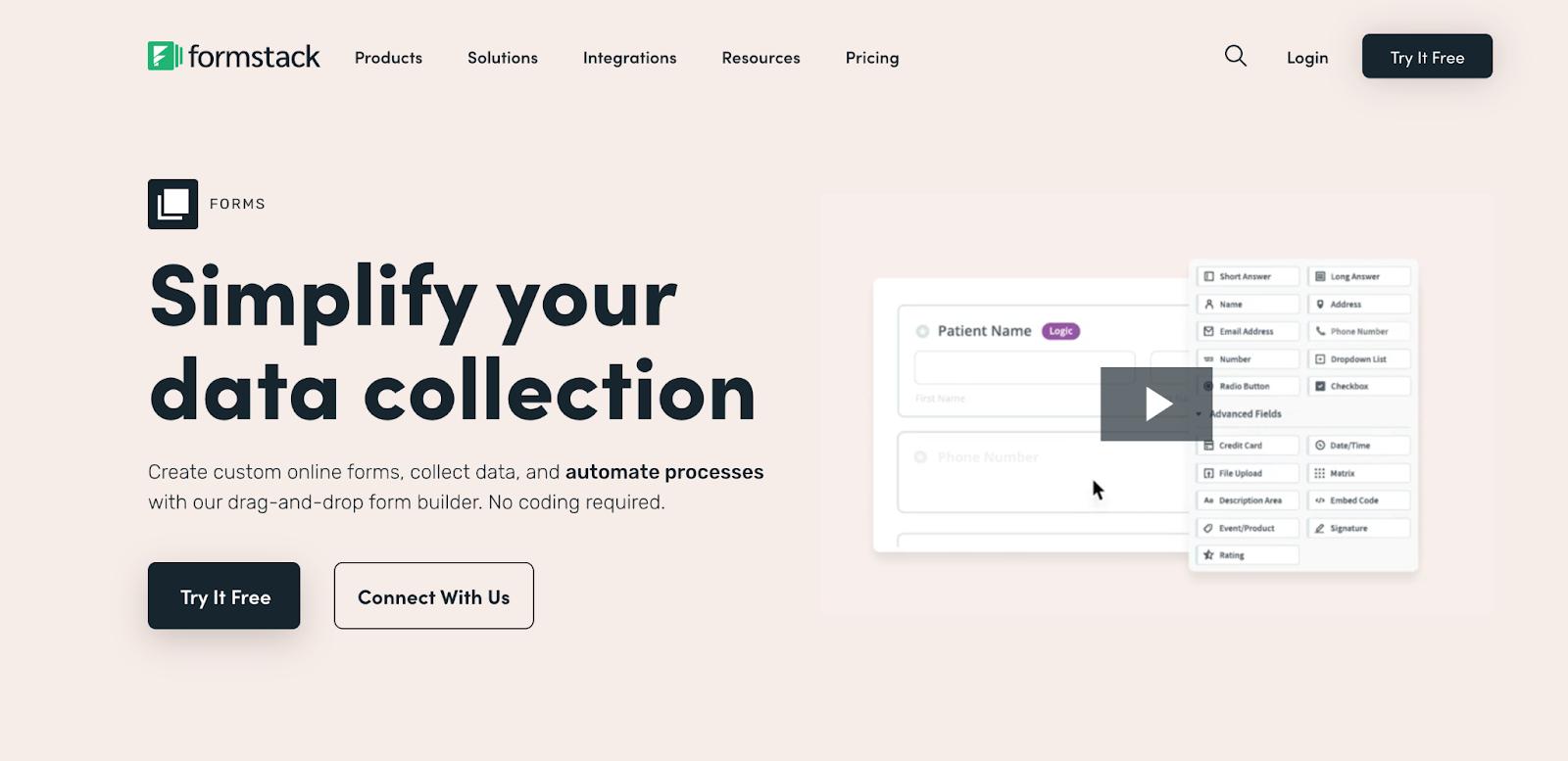
Formstack is a robust platform that excels in creating forms with complex workflows and compliance requirements.
Features:
- Compliance with HIPAA and GDPR
- Advanced workflows and approval processes
- Integration with Salesforce and other CRM software
Pricing:
- Starts at $50/month
- Higher-tier plans available
Pros and Cons:
✅ Strong compliance features
✅ Advanced workflow capabilities
❌ Pricing can be prohibitive for smaller teams
8. SafetyCulture

SafetyCulture is renowned for its emphasis on safety and inspection forms, making it ideal for organizations focusing on compliance and risk management.
Features:
- Mobile-first inspection checklists
- Real-time data reporting
- Incident reporting and analytics tools
Pricing:
- Free starter plan
- Standard at $19 per user/month
- Premium pricing available on request
Pros and Cons:
✅ Highly specialized for safety and quality inspections
✅ Great mobile usability
❌ Overly specific for non-safety-related needs
9. PandaDoc
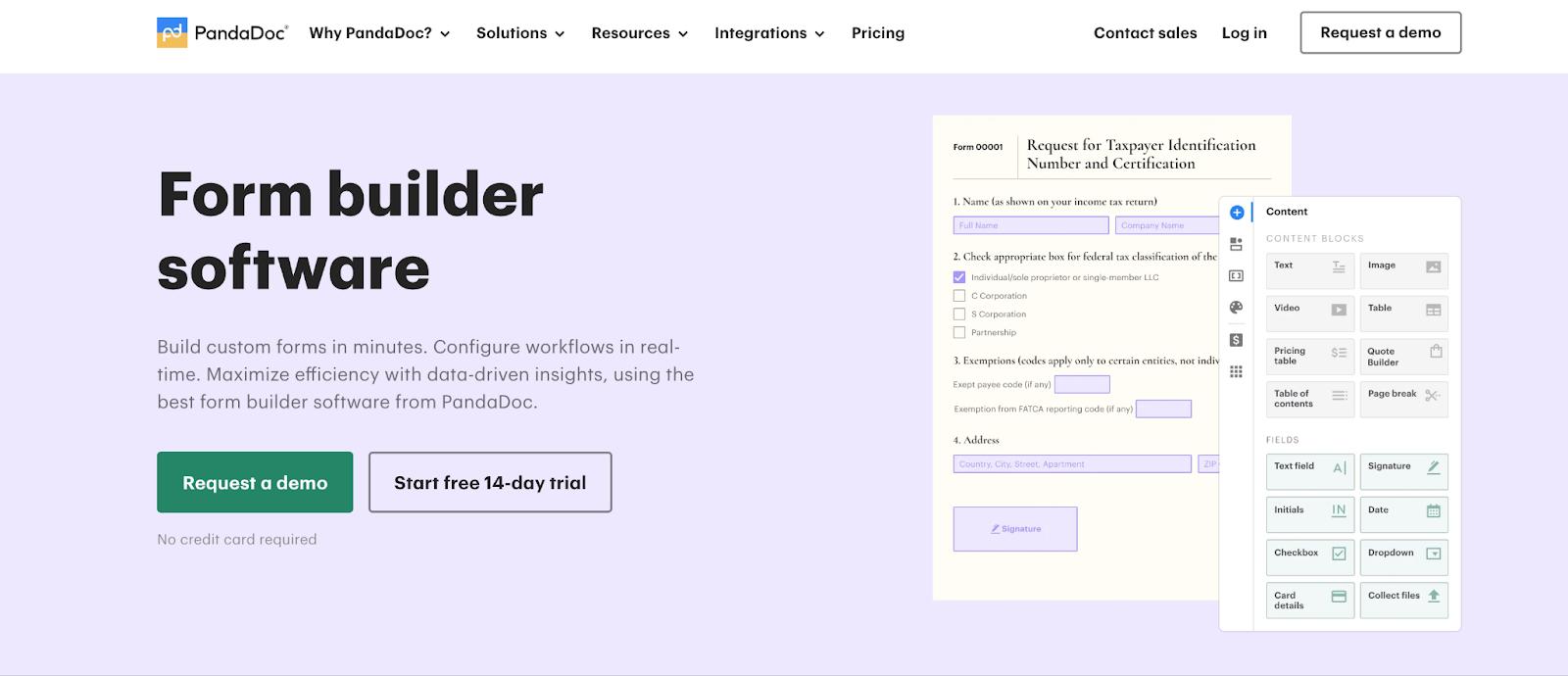
PandaDoc excels in streamlining document workflow by automating the process of document creation, sharing, and tracking.
Features:
- Document automation and e-signature capabilities
- Template and content library
- CRM and payment integrations
Pricing:
- Free eSign plan
- Essentials at $29 per user/month
- Business plan at $59 per user/month
Pros and Cons:
✅ Enhances document management efficiency
✅ Supports legally binding e-signatures
❌ Higher cost for full features
❌ Complex for simple form needs
10. Zoho Forms
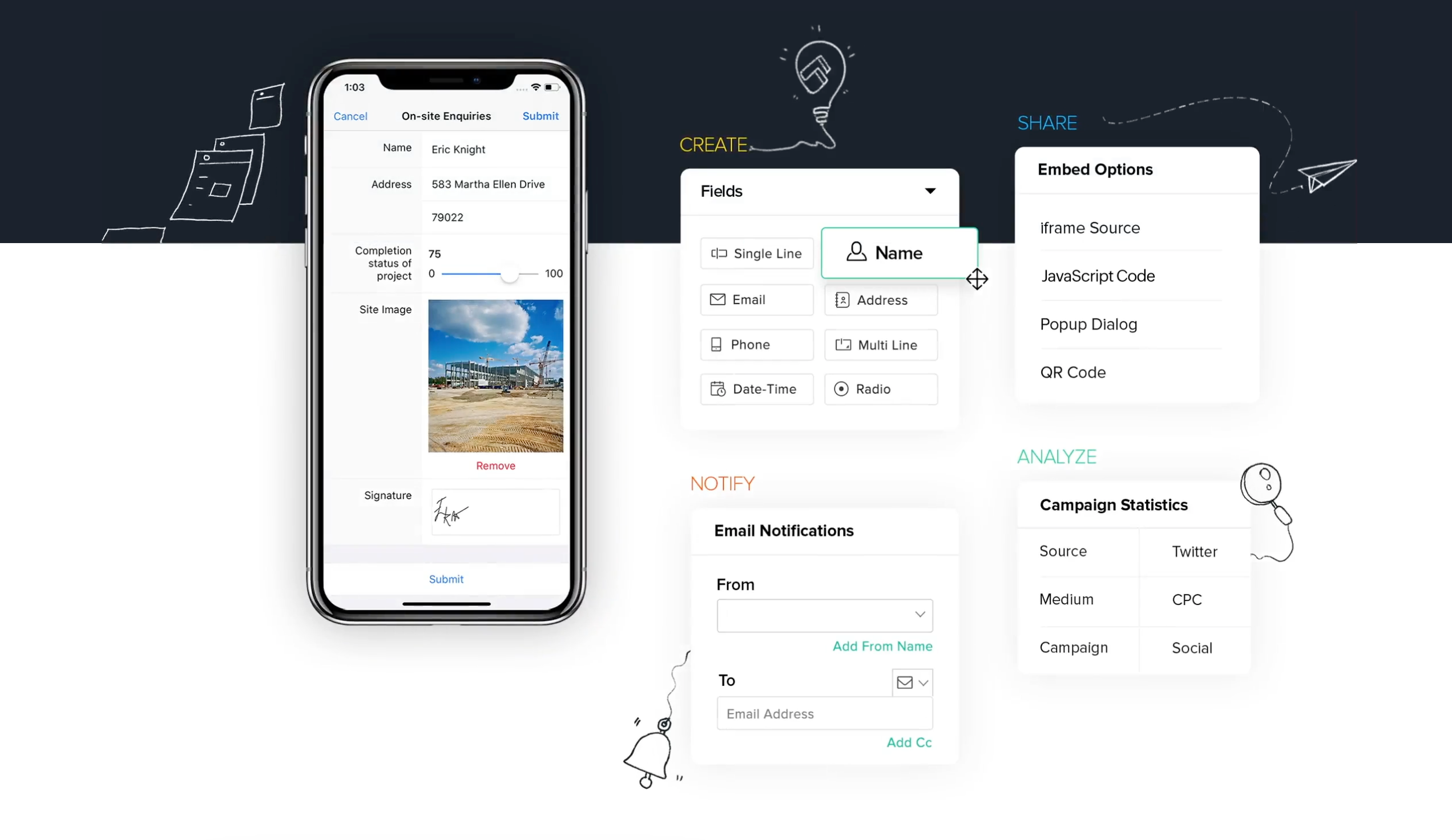
Zoho Forms specializes in simplifying data collection by providing a powerful online form builder that caters to businesses of all sizes.
Features:
- Advanced form building capabilities with logic and branching
- Integration with the Zoho suite and other third-party services
- Real-time notifications and analytics
Pricing:
- Free plan with basic features
- Standard at $10 per user/month
- Professional at $25 per user/month
- Premium at $40 per user/month
Pros and Cons:
✅ Versatile form options and easy to use
✅ Excellent integration within the Zoho ecosystem
❌ Limited features on the free plan
❌ Can be less intuitive for complex form setups
Integrating Form Automation Software with Relay.app
Relay.app is a powerful tool that allows for seamless integration between form software and various other applications and tools.
By connecting your form automation software with Relay.app, you can further enhance your workflow and automate even more tasks across your entire tech stack.
Here’s a detailed look at different automations available through Relay.app:
1. Get Notifications
Integrating form responses with Relay.app to trigger notifications in Slack or via email ensures that your team stays updated in real time.
Whether it’s a new customer inquiry, feedback submission, or a registration form completion, immediate notifications allow your team to respond promptly and efficiently.
This can greatly improve response times and enhance customer service and team communication.
2. Add Leads to a CRM or Email Marketing Tool
Automatically adding form submissions as leads in CRM systems like HubSpot or email marketing tools such as Mailchimp via Relay.app streamlines the sales and marketing process.
Once a prospect fills out a form, their information is directly fed into your marketing or sales pipelines, enabling personalized follow-ups and efficient lead nurturing.
This reduces manual data entry errors and speeds up the conversion process.
3. Create Calendar Events
With Relay.app, you can automate the creation of calendar events in tools like Google Calendar or Calendly when a form is submitted.
This is ideal for appointment bookings, event registrations, or scheduling consultations.
Automatically setting up meetings or events based on form data not only saves time but also ensures better organization and avoids double bookings.
4. Track Responses in a Spreadsheet or Database
By integrating form tools with spreadsheet or database tools like Google Sheets or Smartsuite via Relay.app, you can automatically track and analyze form responses.
This is particularly useful for surveys, application processes, or any scenario where aggregate data analysis is required. It allows for real-time data updating and analysis, making it easier to make informed decisions quickly.
5. Create Support Tickets
When a customer submits a query or issue via a form, Relay.app can automate the creation of support tickets in systems like Intercom.
This ensures that no customer feedback or complaints are missed and that they are addressed in a timely and organized manner. Automating this process helps improve customer support response times and satisfaction.
6. Automatically Assign Tasks
Relay.app can connect form submissions to your project management tools like Todoist, Airtable, Asana, or Trello.
For instance, when a team member submits a project proposal form, it can automatically become a task in the relevant project management tool, complete with deadlines and assigned team members.
This helps keep projects organized and ensures that all tasks are accounted for and actioned upon.
7. Send or Upload Documents
With Relay.app, you can automate both sending documents through platforms like DocuSign and uploading files directly to cloud storage services such as Google Drive.
This dual functionality ensures that whether you need to get contracts signed or store submissions securely, everything is handled automatically.
Automating these tasks not only speeds up the document management process but also reduces the likelihood of errors, ensuring documents are sent to the right recipients and stored safely for easy access.
Get Started with Form Automation
Form automation is one of the simplest ways to start your automation journey.
Tools like Paperform, Typeform, Fillout and other form builders, provide excellent native automations. But you can take these to the next level by integrating with Relay.app. 🔌
Relay.app empowers you to create sophisticated workflows that combine the simplicity of forms with advanced features like human-in-the-loop and in-line AI summaries and data extraction.
The result?
Simplified data management. More efficient processes. Better business operations.
What are you waiting for? Try Relay.app today to see what you can do.
______________________________________
Form Automation Software FAQs
What is the best software to create forms?
The best software for creating forms is highly dependent on specific needs and use cases. Popular options include Typeform, known for its user-friendly interface and engaging forms; Google Forms for simplicity and integration with Google Workspace; and Jotform, which offers extensive templates and powerful integrations.
Which is the best automation software?
Relay.app stands out as the best automation software for teams looking to implement complex, scalable business automations easily. Its unique capabilities, including "human-in-the-loop" steps, collaborative workflows, and AI-enhanced tasks, make it particularly valuable for companies that require flexibility and robust functionality in their automation tools.
This allows non-technical team members to actively participate in and manage automations, enhancing productivity and ensuring more tailored outcomes. There are other great options available depending on your specific needs, including Zapier, Make, and Microsoft Power Automate among others.
What is form builder software?
Form builder software is a tool designed to create digital forms easily and efficiently. It allows users to design, customize, and publish forms without needing extensive coding knowledge. These tools typically provide templates, drag-and-drop interfaces, and various integrations to collect and manage data effectively.
What software is used to automate processes?
Software used to automate processes includes robotic process automation (RPA) tools like UiPath and Blue Prism, which are great for automating repetitive tasks. For workflow automations, tools like Relay.app and Zapier are commonly used to connect different apps and automate tasks across them.
______________________________________
Related reading:





















